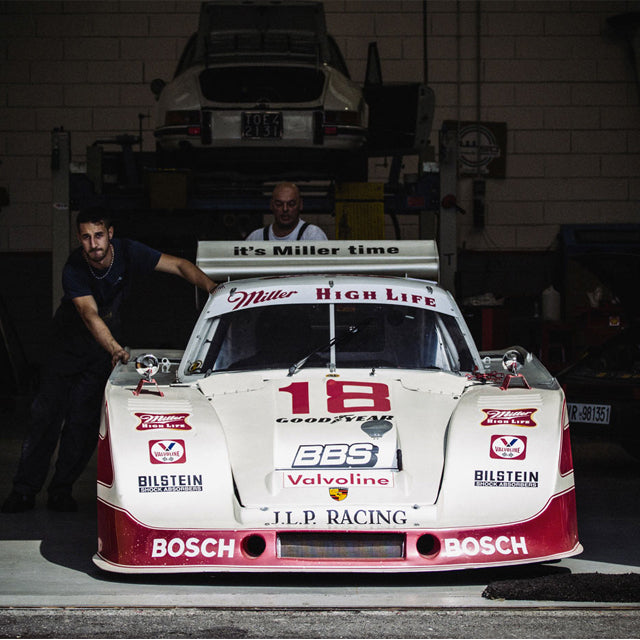


John L. Paul Sr. and Jr., a father and son duo that created the JLP Racing Team, built this special Porsche 935 for competing in endurance races. While many of the specifications were borrowed from previous 935s, the rest of the vehicle was a high-tech, custom racecar with a light fiberglass body, the latest aerodynamics, and suspension. However, the Paul family wasn’t satisfied with this design, and so John Paul Sr. commissioned Dave Klym’s Fabcar to build his son the fastest possible Porsche 935, capable of winning any race. According to Paul Sr., price was no issue.
The Porsche 935 JLP-4 was later designed by one of Fabcar’s top engineers, Lee Dykstra to meet the Paul family's needs, and it was manufactured in Atlanta, Georgia. At this time, Dykstra was best known for producing the DeKon Monza silhouette racers. He was given the challenging task of creating a 935 that was up to par with GTP racers, and he did this by moving away from the tubular space frame chassis found in other 935s. Instead, he used a monocoque design that included ground-effect tunnels that allowed clean airflow due to rocker-actuated springs. In its day, this old car was thought to be one of the most advanced Porsche racing cars available.



Porsche 935 JLP-4 Specifications and Facts Dykstra’s attention to detail allowed the JLP-4 to easily stand apart from the competition. The F6 3200cc Turbo engine was the latest evolution of the Porsche 935 engine, and was mounted as far forward (for a rear-engined car) as it could possibly be placed. It displaced under 3.2 liters, and built from aluminum featuring a single overhead camshaft. Two KKK turbochargers hung off the back, and the engine produced over 840 bhp, feeding power to the rear wheels via a four-speed gearbox.
Weighing in at nearly 2200 lbs (970kg), the JLP-4 reached a top speed of 214 mph (345 km/h). When creating this racer, Dykstra focused much of his development on the vehicle’s sophisticated aerodynamics. He ran extensive testing using the Lockheed wind-tunnel, and this resulted in an exterior design that was a far cry from the average road car. The nose of the car was lower and wider than any other vehicle on the track, and the flanks featured slab-siding so that sliding skirts could be fitted to further enhance the car’s ground-effect aerodynamics.



Porsche 935 JLP-4 Racing History The Porsche factory has an important and deeply rooted history in the racing scene, and many different models from the German manufacturer have stood out in the IMSA racing circuit. The 935 followed racing giants like the Porsche 911 and the Porsche Carrera, and while the 935 on its own wasn’t a major revolution, this collector car had a lot of the components that were needed to claim a victory in GT racing.
The JLP-4 had an impressive record on the track. Most notably driven by John Paul Jr., co-founder of JLP Racing, but Hurley Haywood and Rene Rodriguez also raced the 935. The JLP-4 first raced on July 11, 1982 at Brainerd, where it won overall.



Paul Sr. and his JLP-4 suffered a massive accident while testing at Road Atlanta, and the damage required a full vehicle rebuild. While it was repaired in time for the season finale at Daytona, it was clear that the 935’s racing days were numbed. Its last race was at the Daytona Finale at the end of 1982, where after leading in the opening laps, Paul Jr. was forced to retire after fifteen laps due to a high-speed tire blowout on the bank.
The JLP-4 followed in the footsteps of the JLP-3, which also had some notable achievements during the same time that the JLP-4 was racking race wins. The JLP-3 was the winner of the IMSA Camel GT Championship in 1982 and also won five consecutive races while enjoying 16 podium finishes out of 26 races. The JLP-3 was also the only car to ever win both the Sebring 12 Hours and the Daytona 24 Hours within the same year.
During its short yet successful racing career, the Porsche 935 JLP-4 had several notable sponsors. JLP Racing was the most prominent, but Miller also sponsored. The Miller logo was featured in red on the roof of the car with the slogan “It’s Miller Time” across the rear spoiler.



Porsche 935 JLP-4 In Review To this day, the 1982 Porsche 935 JLP-4 is one of the most sophisticated 935s, and it is the only model to offer full ground-effect aerodynamics. As the last of the JLP racing build specials, the JLP-4 may be one of the Paul family's greatest claims to fame, earning several race wins in 1982 and 1983.
These days, the Porsche 935 JLP-4 is a collector item. For many classic car enthusiasts, getting to see the 1982 Porsche 935 JLP-4 up close is a real treat, but actually owning one is impossible.
Matt is a managing partner at Leland-West Classic Car Insurance. As an avid classic car nut, Matt has been known to work for parts :) You can reach Matt at Matt@LelandWest.com. Thank you to Mr. Borella for allowing us to photograph his car.



























































